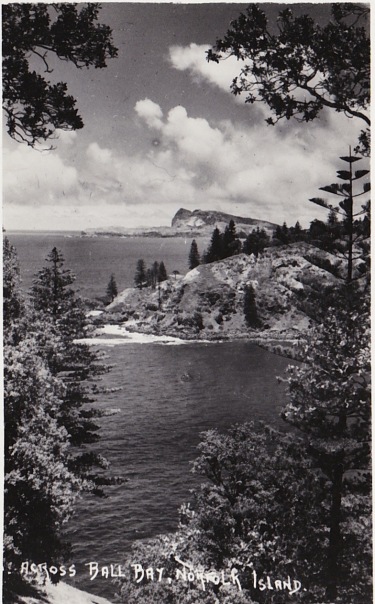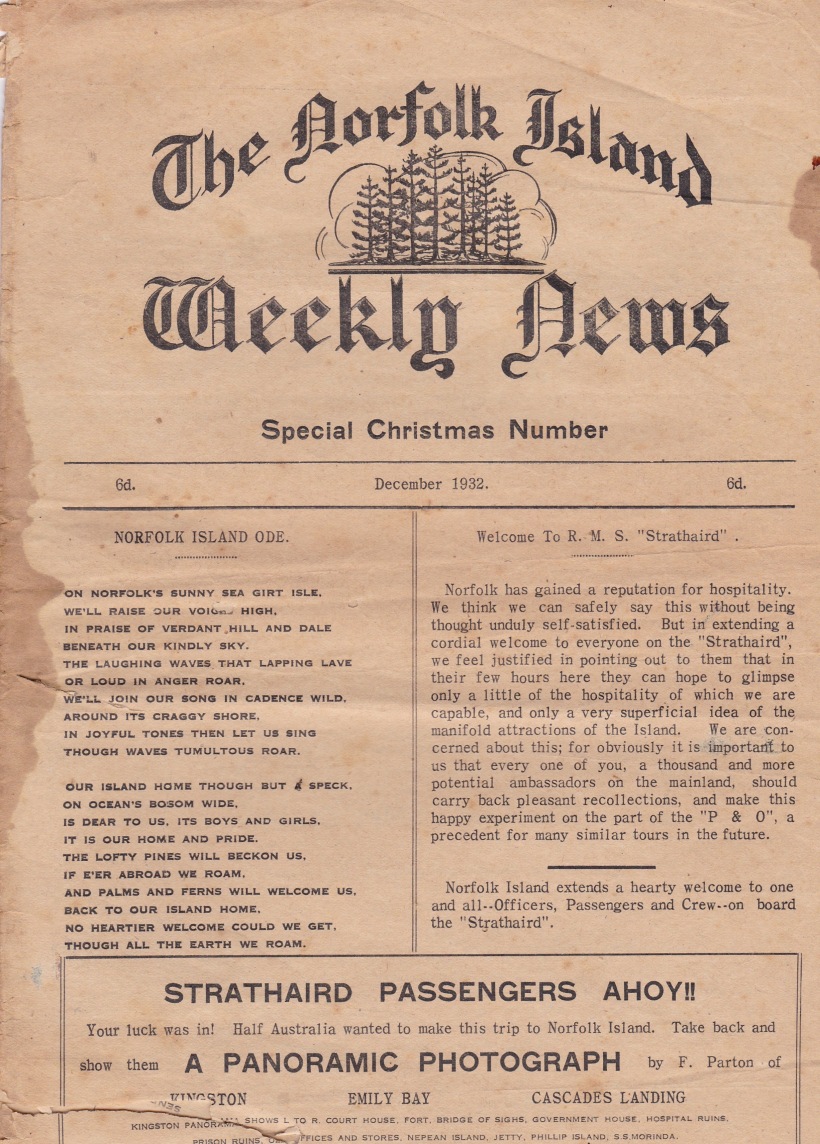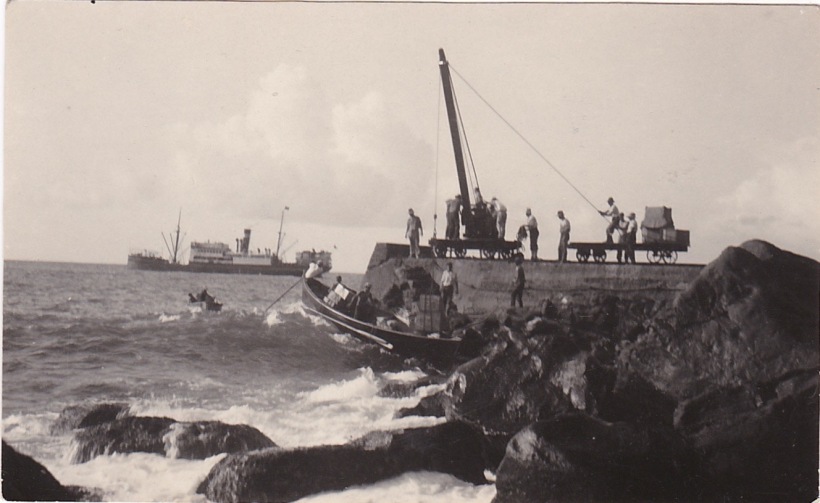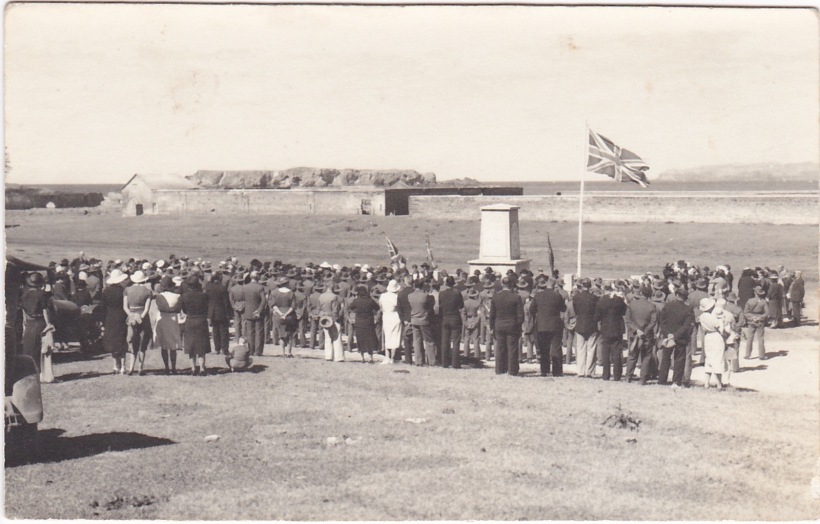
I always understood that Ella Price (my paternal grandmother) and Mr Munro spent the War Years on Norfolk Island, 1,670 kilometres north west of Sydney. The only proof I have of their time on the island are the photos my grandmother took, the postcards she bought, her copies of the Norfolk Island Weekly that are still in my possession and the letters sent from friends who remained on the island after they left.
I really don’t know if they had been there before but my grandmother kept copies of the Norfolk Island Weekly from Christmas 1932 and 1933. Significantly in 1932 the first cruise ship to leave Sydney Harbour, the “Strathaird”, is commemorated in the Dec 1932 issue of the “Weekly News”.


Knowing Alfred Munro’s excessive care with money I doubt they would have splurged on a cruise, but I remain eternally grateful for the financial help he gave my father.
In the March, 1939 edition of the Norfolk Island Weekly the following announcement was made:
The Morinda arrived from Sydney yesterday with 85 bags of mail, 142 tons of cargo and the following passengers:-
Mrs Adams, child and infant, Misses C & M Barr, Mr D Buffett, Miss M Brett, Mr A Carter, Mr E C Fahey, Mr J W Jenkins, Mrs H Kelly, Mr and Mrs L Michaelis, Mr W Maher, Mrs G Menzies, Mr A Munro, Mr and Mrs J Part and infant, Mrs E Price, Mr K Robinson, Mrs R Raff, Mr and Mrs W Thornton, and child.

Note that Alfred and Ella were discretely separate. The landing at Norfolk Island was tricky to say the least. Depending on the prevailing winds the ships would send smaller boats (lighters) to either Kingston Pier or Cascade Landing on the opposite side of the island.


Until the Americans built a landing strip during World War 2 this was the only way to get on the island.
Norfolk Island has an amazing history. The island was settled by Polynesian Seafarers who came and went around the 14th Century. When Captain Cook arrived on his second voyage in 1774 he was impressed by the tall pine trees and the flax plants. The first convict settlement at Botany Bay wasted no time in establishing a penal settlement on Norfolk Island. Alas no-one was skilled to process the flax and the pines proved unsuitable for masts. Eventually the convicts were moved out so that the island lay abandoned to nature between 1814 and 1825.
In 1824 the British Government gave instructions to send “the worst description of convicts” to the island. This was a period of well documented harsh treatment and brutality. The last convicts were moved to Tasmania in 1855 as convict transportation from Britain ceased.

Norfolk Island was peaceful again.
A new wave of settlers arrived in 1856 from Pitcairn Island. These were the descendants of the Bounty Mutineers and the Tahitian men and women who accompanied them. One hundred and ninety four people moved from their remote tiny island in the South Pacific after petitioning the British Government for help.
During World War 2 the island became a key airbase and refuelling depot between Australia, New Zealand and the Solomon Islands. It was garrisoned by a New Zealand Army unit known as N Force at a large Army camp. The island proved too remote to come under attack during the war and N Force left the island in between 1944 and 1946.

In 1942 the much admired trees in Pine Avenue were sacrificed for an airstrip as the Pacific War escalated.
Postcards from friends on the island show that Mr Munro and Ella must have returned to Australia in 1940. The War in the Pacific had not started so the airfield and the army camps were a thing of the future. Mr Munro would have enjoyed the peace, beautiful scenery, friendship and a game of bowls during his time on the island. My grandmother, Ella, I am sure, would have relished living in an environment far removed from the outback of Australia.
So it looks as though I got it completely wrong about Ella and Mr Munro spending the war years on Norfolk Island as it appears they arrived in March 1939 before World War 2 began and left before the War in the Pacific started.



Appreciate the depths of history you have gathered. Also appreciate your eye for details! Norfolk island seems to have a great historical background! Thanks for sharing!
————————————————
Anagha From Team MocktailMommies
Collage Of Life
LikeLiked by 1 person
The more we dig, the more we, eventually, find. 🙂
LikeLiked by 1 person
This is mostly all new to me. The pines look beautiful. The small boats arriving on the rocks look frightening.
Finding Eliza
LikeLike
That is so interesting. I had no idea about Norfolk Island in WW2 but I suppose it makes sense.
LikeLiked by 1 person
We visited Norfolk Island in 2001. It is a fascinating place.
LikeLike
LInda, another wonderful story and I so relate to the struggle trying to discern fact from fiction andd trying to get it right. I went to Norfolk Island around 1982 with my parents and brother and we loved roaming around the island and exploring convict ruins beside the road and in town. My grandmother, the concert pianiost, also permed in Norfolk Island during the 1970s and used to bring me back these very ornate dresses with layers of petticoats underneath. They were extraordinary. My grandparents had also been longstanding friends of Ruth Park and D’Arcy Niland. Ruth Park lived at Norfolk Island for many years.
Since meeting my husband, I’ve found out our original Newton was a convict, John Newton, who was initially sent to Norfolk Island and was one of that group who was transferred to Van Dieman’s Land in 1855. I think we need to get back there some time, ideally before the kids flee the nest, although goodness knows when anyone is going to travel any time soon.
Best wishes,
Rowena
LikeLike
Sorry, that should read James Newton.
LikeLike